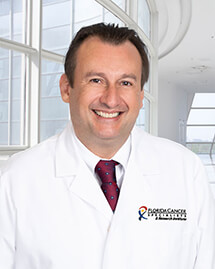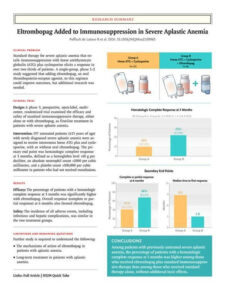Author(s): Régis Peffault de Latour, M.D., Ph.D., Austin Kulasekararaj, M.D., Simona Iacobelli, Ph.D., Sofie R. Terwel, M.Sc., Riley Cook, B.Sc., Morag Griffin, M.D., Constantijn J.M. Halkes, M.D., Christian Recher, M.D., Ph.D., Fiorenza Barraco, M.D., Edouard Forcade, M.D., Ph.D., Juan-Carlos Vallejo, M.D., Beatrice Drexler, M.D., et al., for the Severe Aplastic Anemia Working Party of the European Society for Blood and Marrow Transplantation*
Author Affiliations
From the French Reference Center for Aplastic Anemia and Paroxysmal Nocturnal Hemoglobinuria, Saint-Louis Hospital and Université de Paris (R.P.L., F.S.F., C.F., G.S.), and the Adolescent and Young Adult Hematology Unit, Saint-Louis Hospital (F.R.), Paris, the Hematology Department, Centre Hospitalier Universitaire de Toulouse, Institut Universitaire du Cancer de Toulouse Oncopole, Toulouse (C.R., S.T.), Centre Hospitalier Universitaire Lyon Sud, Lyon (F.B., A.P.), Centre Hospitalier Universitaire de Bordeaux, Hôpital Haut-Lévêque, Pessac (E.F., L.C.), the Department of Clinical Hematology, Rennes University Hospital, Rennes (J.-B.M.), Service d’Hématologie, Hôpital Jean Minjoz, Besançon (E.D.), and Hôpital Claude Huriez, Lille (L.T.) — all in France; the Clinical Study Unit, European Society for Blood and Marrow Transplantation (R.P.L., A.K., S.I., S.R.T., I.S.-O., C.F., C.D., A.M.R.), and the Department of Hematology, Leiden University Medical Center (C.J.M.H., J.M.L.T.), Leiden, the Department of Hematology, University Medical Center Utrecht, Utrecht (R.A.P.R.), the Department of Hematology, University Medical Center Groningen, Groningen (M.R.G.), and the Department of Clinical Hematology, Amsterdam University Medical Centers, Academic Medical Center, Amsterdam (E.N.) — all in the Netherlands; the Department of Haematological Medicine, King’s College Hospital NHS Foundation Trust (A.K., R.C., A.E.S., P.M., J.C.W.M., G.J.M.), and Barts Health NHS Trust, St. Bartholomew’s Hospital (J.C.), London, the Department of Haematology, St. James’s University Hospital, Leeds (M.G., T.M., A.H., P.M.), and the Centre for Clinical Haematology, Nottingham University Hospital, Nottingham (N.H.R.) — all in the United Kingdom; the Department of Biology, Università Tor Vergata (S.I.), and the Department of Translational and Precision Medicine, Division of Hematology, Sapienza University (A.P.I., U.L.R.), Rome, Ematologia e Centro Trapianti, IRCCS Ospedale Policlinico San Martino (E.A., M.T.L.), and the Hematology Unit, IRCCS Istituto Giannina Gaslini (E.P., C.D.), Genoa, Unità Operativa Complessa di Ematologia, Unità Operativa Complessa di Fisiopatologia delle Anemie, Fondazione IRCCS Ca’ Granda, Ospedale Maggiore Policlinico, Milan (W.B.), the Department of Clinical Medicine and Surgery, Federico II University, Naples (S.M., L.M., F.C., C.F., A.M.R.), and Ematologia e Trapianto Emopoietico, Azienda Ospedaliera di Rilievo Nazionale San Giuseppe Moscati, Avellino (L.M., C.F., A.M.R.) — all in Italy; University Hospital Donostia, San Sebastián (J.C.V.), the Department of Hematology, Catalan Institute of Oncology Bellvitge Hospital–Hospital Duran i Reynals, L’Hospitalet de Llobregat (A.S.), Institut Català d’Oncologia, Hospital Germans Trias i Pujol, Josep Carreras Leukemia Research Institute, Barcelona (B.X.), and Servicio de Hematología y Hemoterapia, Hospital Universitario y Politécnico La Fe, Valencia (I.J.) — all in Spain; and the Department of Hematology, University Hospital Basel, Basel, Switzerland (B.D., J.R.P.).

